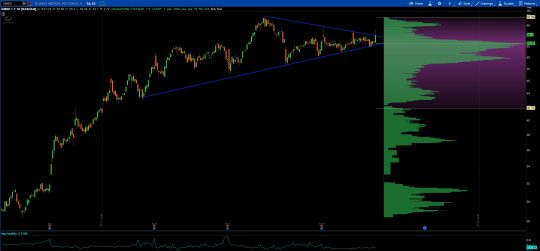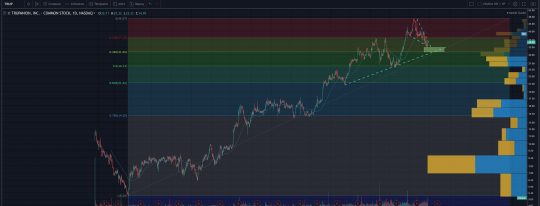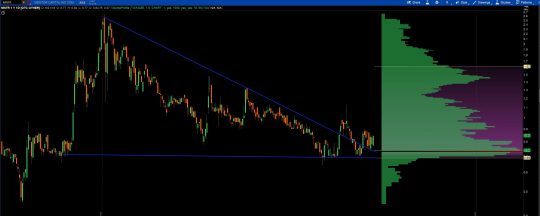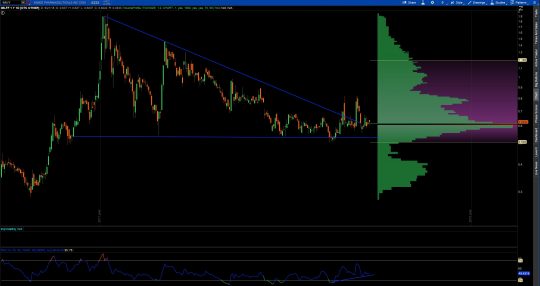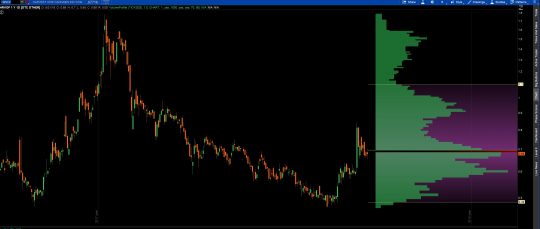[vc_row el_id=”LONG TERM COMMENTARY”][vc_column][vc_column_text]
Real estate indices are lining up for punishment on both sides of the border.
Proponents of the modern portfolio theory suggest diversification is the best strategy to reduce investment risk in a world nobody can predict the future of individual investments or markets as a whole. In other words making a number of clueless bets as opposed to one or a few, in and by itself, is supposed to increase your chance of success in the markets. This is equivalent to going hunting blindfolded and firing chaotically in all directions upon hearing a bear coming to get you. You’d be very lucky to survive any one individual attempt, let alone a couple in a row!
Analysis of market behavior is better that way. We technicians do accept that correlations, positive or negative, are time dependent over any time horizon; or that multiple asset classes or companies or even countries do not ALWAYS have to move in counter-cyclical fashion for that matter. We do want to leave the door open to allow the market to do all it wants to do, extreme or not, and just listen to the balance of supply and demand to understand what is more likely to happen. By default, we do accept things can and will go against us at times which is why we use stops and have built-in back up plans. This is more like going hunting with your eyes uncovered, aware of how you could best use bullets to capitalize on opportunities or to deflect risks. Hunting is risky business after all but at least you have the tables turned in your favor and stand a better than 50% chance of surviving the eventual bear encounter this way.
I told you this because any modern portfolio theory you’ll read will tell you diversification to real estate is like a hedge during stock market corrections. I will not point towards the 2007-2009 counter-example to dismiss that premise because it would be all too easy. But I will say this. In a world where no portion of the yield curve were controlled by Central Banks the paper / hard assets competition would be counter-cyclical in nature. This is how investment complements would tend to behave in relation to each other while competing for resources in a given pool of liquidity that can only expand with economic growth or inflation. But that’s not what our setup looks like. Our setup is Central Banks are actually free to manipulate interest rates and expand liquidity even in the absence of real economic growth, leading to situations of inefficient allocation of capital that are ultimately resolved with hard landings. This is when all asset classes begin to move higher or lower in sync because what is happening is the common denominator in which all investments are measured – i.e. money – simply sees its supply increased and its value decreased or vice-versa. In other words, the growth and decay of asset prices is largely a monetary thing rather than an economic thing. By any objective measure this is what the US experienced during the Bush and Obama years. This is also what Japan has experienced since 1989. And this is what Europe experienced since the “unification” of Northern and Southern Europe in the idiotic single currency project since 1999-2002. Across the whole West, we’re addicted to debt to maintain our standards of living. It can’t last forever and there’s evidence a re-alignment of some nature is upon us.
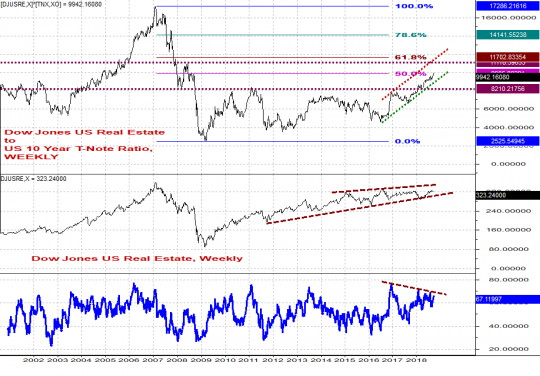
Now, just remember the chart we’ve shown you last week whereas the S&P times the 10 year yield is UNDER the year 2000 peak while the S&P itself is double its corresponding level. The real estate sector, as represented by the Dow Jones Real Estate Index, is in an even worse mid to long-term position so don’t let anybody tell you hard assets will act as a hedge during the eventual stock market correction. First off, in nominal terms, unlike the broader indices, the real estate index has thus far failed to make a new high during this bull market. Quite frankly if real estate hasn’t printed a new weekly high during the QE program it will have no chance doing it in a rising interest rates environment. Secondly, the real estate index times the 10 year yield ratio has barely retraced 50% of its 2007-2009 collapse. In essence the unprecedented monetary stimulus since 2008 failed to really ignite a fire under the real estate sector. These are anything but exciting developments because such a market behavior suggests the long-term miss-allocation of capital in this sector is still largely unresolved – which in turn means the long-term corrective process that started in 2007 is NOT OVER.
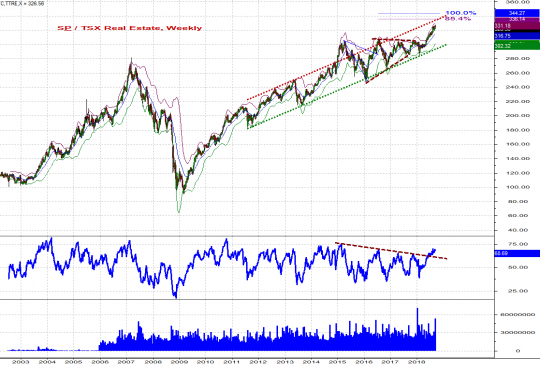
The situation is somewhat different in Canada in the sense that the S&P TSX Real Estate did make a new high though on diverging weekly momentum. The setup here seems to be that the long-term cycles that closed in 2007 in the States are now closing out in Canada. While US housing prices are already mid-way into a multi-decade sideways trend, Canada is merely finishing its own long-term advance and is just about to begin the first leg down in a very large sideways correction, our own 2007-2009. Facing facts, the Canadian economy is far less diversified and in many ways weaker than the US economy, our Canadian Dollar is NOT the world’s reserve currency, unlike the US we do not really have an army, the debt to income ratio at the personal level is at a staggering 172%, the finances of our three largest provinces are beyond repair and to top it all off our current leadership is rather confused as to the importance of getting along with whomever occupies the White House. Real estate both in Canada and the States will suffer but on a relative basis Canada will fare far worse from this point on because more excesses have built-in during the current up-cycle than in the States. The reverse was true in 2007 which is why the US got hit far worse, now it is Canada’s turn.
In understanding what our long-term position truly is, I will tell you an anecdote we have in Eastern Europe – which is where I am originally from. There were two guys chatting, a pessimist and an optimist. The pessimist was drinking whiskey and after having a bit too much he sniffed his glass and said “hmmmm, this kinda smells like bedbugs”. The optimist listening to him bored to death sees a bedbug on the wall, catches it, sniffs it and goes “hmmmm this kinda smells like whiskey”. And here’s the deal, I would rather be a pessimist that drinks whiskey than an optimist that sniffs bedbugs. Our view regarding the long-term setup in the markets is above all realistic, largely because denial of facts or irrational hope are not known to be very successful trading or investment strategies. The good news is, in the coming environment the whole buy and hold mantra will rapidly disappear and the need and demand for some quality market timing abilities will go through the roof. The more you will be able to think like a professional trader, the better off you will be. In essence one of the bull markets the coming market correction will ignite will be the bull market in quality technical analysis. If you’re reading these pages, you already embarked for that trend rather well ahead of time. Despite the mid and long-term risks we’ve exposed we do believe there will always be a short-term market with things to buy and sell. It’s just that a lot of times we tend to be our own worst enemies and marry positions we should not, as they say an investment is little more than a trade gone bad. It is that kind of conventional thinking and associated implications we want to keep you away from during this transition process, which as it stands out, as of tonight, is an important setup awaiting the eventual trigger. We haven’t triggered anything just yet but stars are aligned in such a way that it seems to be nothing but a question of time…….[/vc_column_text][/vc_column][/vc_row][vc_row el_id=”PATTERN ANALYSIS”][vc_column][vc_column_text]
PATTERN ANALYSIS
S&P 500 Large Cap
Adjusting short-term key support at 2885 / 2858, we will allow the SPX carry towards 2959 / 2980 and possibly 3031 prior to forming a higher profile top.
PREVIOUSLY ::::: Overall we continue to believe the advance from the FEB / APR lows completes a larger mid-term cycle from the 2016 bottom which means the biggest correction in at least 2-3 years is looming.
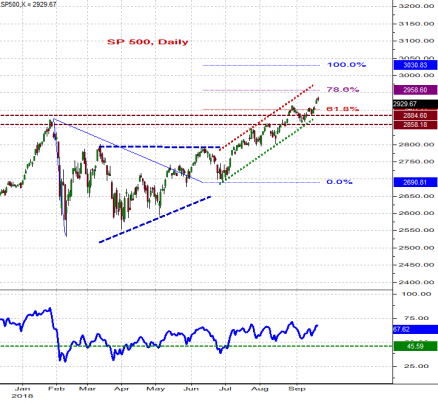

S&P 400 Mid Cap
The price action we’ve seen in the MidCaps this week brings absolutely nothing new.
REPEAT :::::: We’re still working with the case a rising wedge is playing out in the daily time frame to close out the mid-term uptrend that started in 2016. Resistances at 2050 / 2070 / 2083 are solid, support at 2001 / 1961 will ultimately prove anything but …….
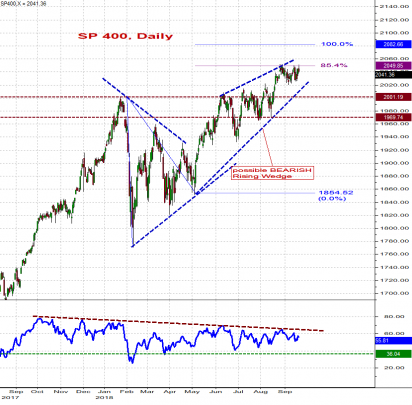

S&P 600 Small Cap
UNCHANGED::::: As the USDollar is beginning to hurt, so do the Small Caps. Strength into 1100 / 1124 is terminal in nature while pushes below 1068 / 1050 could well signal the beginning of an important pullback.
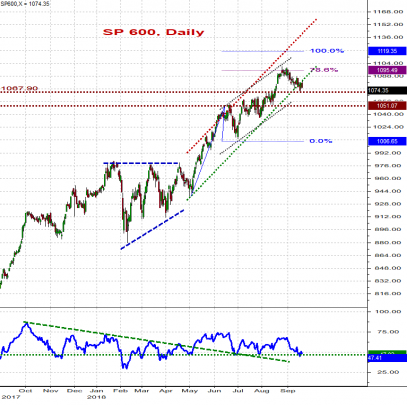

Dow Industrials
Near-term weakness in the dollar has the large and mega caps sailing with wind from behind. We will adjust key support at 26155 / 25750 and allow this thing to continue higher towards 27220 / 27700. No matter where this rally carries in the short-term, its ultimately terminal nature for the larger mid-term uptrend can simply not be disputed given that it arises out of an earlier 4-6 months triangle (moves out of triangles typically close out the one larger degree trend).
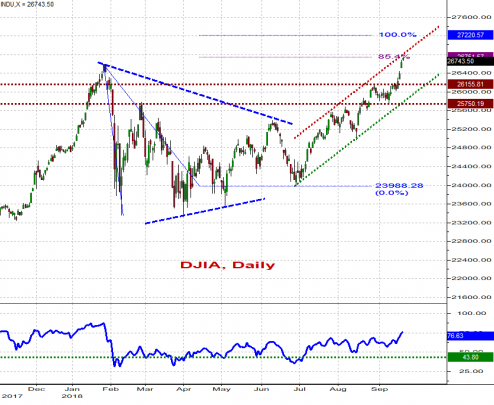

Dow Transportation
Prices have continued to consolidate above nearby structural support so they remain in cards to make higher highs yet. Unless we drop below the 11410 / 11254 / 11128 progressively more critical supports, the DJTA should take a shot at 11817 prior to establishing a more significant mid-term peak.
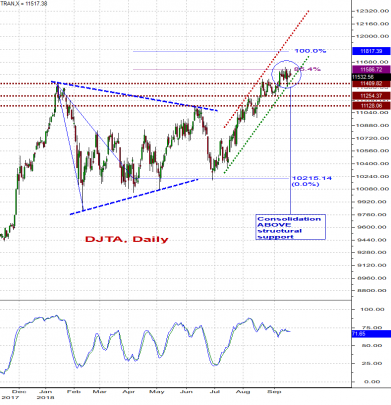
 Dow Utilities
Dow Utilities
The Dow Utilities remain the lemon of the pack here – as we’d expect given our outlook on interest rates. We continue to view the 721 / 712 and then 700 supports as pivotal in nature and overall we continue to think the bigger risk here is for a multi-week sell-off into the 590-620 area.
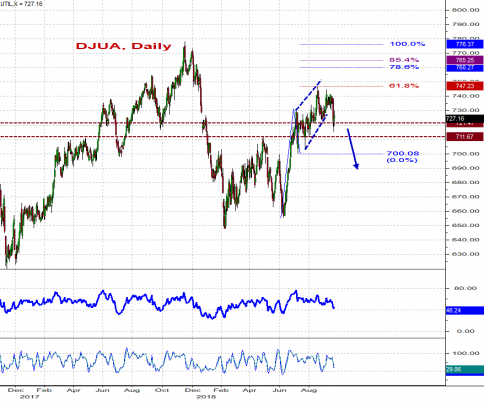

Russell 1000
The buoyancy of the large cap space and the relative quietness of the mid cap space are enough to push the Russell 1000 higher. We will tighten risk at 1589 / 1576 while allowing the RUI carry to the next objectives of 1643 / 1656.
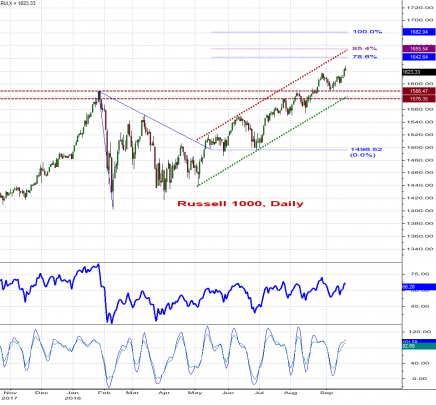

Russell 2000
The near-term underperformance of small caps can be attributed to the current short-term pullback in USDollar. But unless prices here dip below 1700 and then 1634 – 1652 the Russell 2000 remains in cards to print anywhere within the 1789 / 1814 range before a more significant top forms.

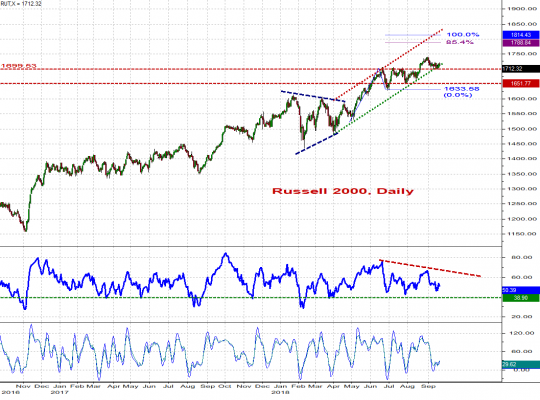 Nasdaq 100
Nasdaq 100
UNCHANGED :::::: REPEAT :::: The rising wedge appearance of the past few month’s rally is rather obvious. The NAS 100 is to remain supported at 7312 / 7163 if additional upside potential towards 7724 / 7851 is still due. Breaks below 7312 / 7163 must be treated as the beginning of a trip lower towards 6800 / 6500.

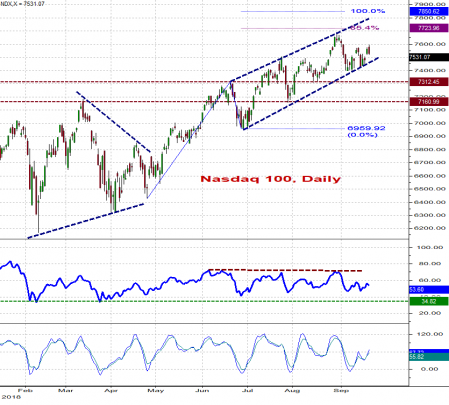
Nasdaq Composite
UNCHANGED :::: REPEAT :::::: The picture is identical with the NAS 100 though the levels are slightly different: key supports are located at 7723 / 7630 and then 7423 / 7333 while resistance for a terminal rally is located at 8146 / 8271.

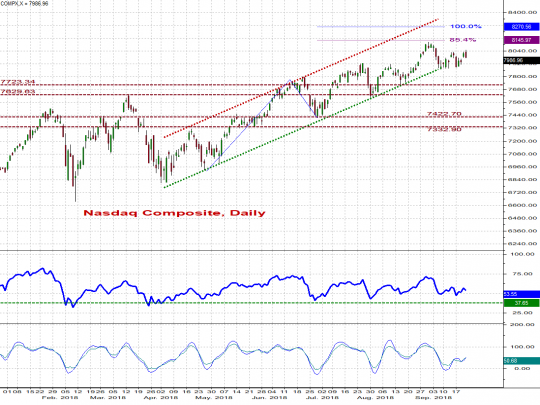 [/vc_column_text][/vc_column][/vc_row][vc_row el_id=”STOCK PICKS”][vc_column][vc_column_text]
[/vc_column_text][/vc_column][/vc_row][vc_row el_id=”STOCK PICKS”][vc_column][vc_column_text]
WEEKLY STOCK PICKS
IBKR
| DIRECTION | BUY ZONE | SELL ZONE | RISK/REWARD | VEHICLE |
| UP | $55-57 | $70-75 | -$2 – $18 | OPTIONS |
IBKR has been giving back gains for the past 4 months as it is putting together the makings of a falling wedge pattern that is marked by a bullish momentum divergence. We can see that as price trades lower, the RSI has been trending higher which often signals bulls are strengthening and soon will push prices higher. Coming into the final trading week of September, watch for one more low into the apex of the wedge pattern and that is where we want to put on a long trade. If price can manage to break out of the pattern we should see a move towards $70 into the end of the year. I’ll be looking to put on a trade via an options play into October for starters. The $55 strike is the safe bet with the $60 strike being more aggressive.
KORS
| DIRECTION | BUY ZONE | SELL ZONE | RISK/REWARD | VEHICLE |
| UP | $72.15-73 | $77-78 | -$.75-$5.00 | OPTIONS |
KORS recently broke away from a consolidation range and traded higher forming a pennant pattern after the breakaway gap. With ample support underneath I think this move can be played right here and now with options to define our risk. Within the pennant pattern we are near the lower bound and I will be looking for October options early this week. My preference will be the $74 or $75 strike calls.
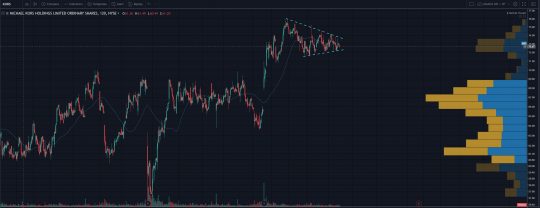
GMED
| DIRECTION | BUY ZONE | SELL ZONE | RISK/REWARD | VEHICLE |
| UP | $52.50-54 | $63-64 | -$2.00-$9.00 |
Coming into this week I will be looking to take a position in the $55 strike October calls in GMED. This is a trade with strictly defined risk as we have support directly below from a trendline as well as a volume point of control taking into account one year of price history at the daily level. Price temporarily broke out of the consolidation pattern on Friday before pulling back leaving an upper shadow. I believe this was simple profit taking characteristic of an option expiry Friday and we can expect to see the bulls provide more strength early this week which will serve to break us out of the pattern to trade higher.
NOW
| DIRECTION | BUY ZONE | SELL ZONE | RISK/REWARD | VEHICLE |
| UP | $186-190 | $200-205 | -$3-$10 | OPTIONS |
An old favorite, $NOW is trading in a well-defined channel that is worth playing as prices come back into the lower support trendline. Channel patterns with clear cut higher and lower bounds are some of the most straight forward trades the market has to offer. You know right where you are wrong, should price trade beneath the lower trendline, and you have a good idea of a price target on the top side so it makes it easy to play options. Get long as close to the lower trendline as possible and play for a move back to the upper resistance level.
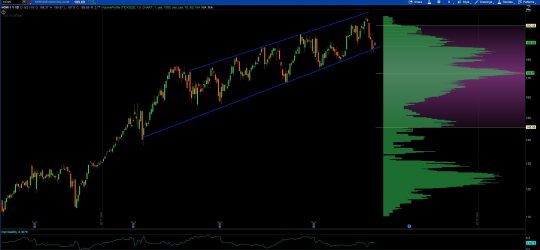
TRUP
| DIRECTION | BUY ZONE | SELL ZONE | RISK/REWARD | VEHICLE |
| UP | $31-32 | $45-46 | -$4-$10 | OPTIONS |
New to my watchlists is TRUP, an accident and health insurance name. This category of stock is generally slower but this one looks to be a mover and is setting up just the way I like. We have a falling wedge pattern coming into a confluence of a Fibonacci Retracement level as well as trendline support. We can see that on Friday the stock showed signs of strength which I think will continue. I will be looking to buy this on any hopeful pullbacks which I think we will get one on a market pull back. October $35 strike calls or a bull call spread to help finance the trade with a $35-40 strike vertical might be the play here depending upon your risk appetite.
SPECIAL NOTE
For this week’s top equity list, I wanted to include 5 of the top setups from the cannabis industry group. For those who haven’t followed, this group has been hot as of late and many names are exhibiting the kind of moves we saw in cryptocurrencies last year starting about this time. While there are certainly major players in this space like $GWPH which was a setup that I’ve been in for some time, the real opportunity lies in the OTC stocks. There are some of the best looking setups in the entire market in the cheap cannabis names. This being said, they are speculative and volatile. In the early stages of an industry group still in its infancy, the best approach is to build your own basket of 10 or so names and run it like your own ETF. Some companies will thrive, others will get acquired, and others might not stand the test of time. Pick 10 of your favorites, allocate a specific percentage to each and a year from now I think you will be handsomely rewarded. You can treat these cheap OTC stocks as options minus the theta.
To get you started, here are my top 5 favorites in this space here and now…
NOTE: All plays here will be stock, most of which will be OTC or over the counter non exchange listed. Your broker has to approve you to trade these so make sure you have approval and understand your broker’s requirements.
MNTR
MNTR broke out of a descending triangle pattern recently and then pulled back to retest near the scene of the breakout. MNTR is supported directly beneath by the breakout point as well as the one year VPOC level. You are safe to get long here, adding to your position should it trade back to the .75c mark. The width of the pattern is from $2.60 to .70 or $1.90. Adding $1.90 to the breakout level of .75 gives us a price target of $2.65.
SRNA
SRNA broke out of a descending triangle pattern recently and then pulled back to retest near the scene of the breakout. SRNA is supported directly beneath by the breakout point as well as the one year VPOC level. The width of the pattern is from .50 to .14 or .36. Adding .36 to the breakout level of .14 gives us a price target of .50.
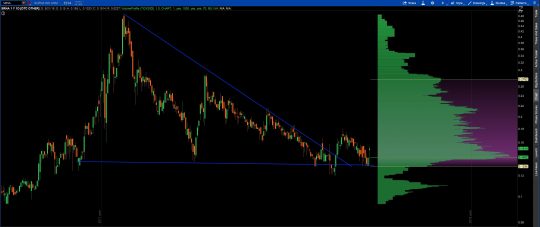
IMLFF
IMLFF broke out of a descending triangle pattern recently and then pulled back to retest near the scene of the breakout. IMLFF is supported directly beneath by the breakout point as well as the one year VPOC level. The width of the pattern is from 1.90 to .53 or 1.37. Adding 1.37 to the breakout area of .62 gives us a price target of approximately 2.00.
HRVOF
Taking on a slightly different personality is HRVOF. A recent bullish surge higher has pulled back directly to the yearly VPOC and is flagging right at that level. We want to get long here as we can see lower shadows being put in on the daily candles over the past week’s trading sessions. While the measured move isn’t as defined with this one I think the $1.10 level at the top bound of the value area is a target we can expect in the next couple of months.
TRTC
The opportunity in TRTC cannot be understated, however a pullback is needed to get in. Put this one on a watchlist and set an alert on your platform for a price at or under $1.90. The width of this pattern serves up quite the opportunity. $7.50-2.40 leaves us 5.10 to add to the breakout area of 1.80 for a price target of close to $7.00. I am heavily invested in this name from just lower and you will want to make this a staple in your pot-folio.
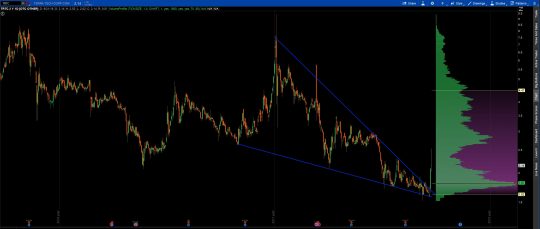 [/vc_column_text][/vc_column][/vc_row]
[/vc_column_text][/vc_column][/vc_row]


